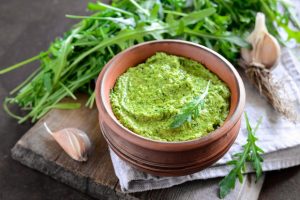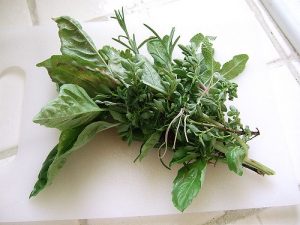Last week’s sound experiment of sourdough flatbread with arugula, basil, lemon, and olive oil spread was a failure and I couldn’t help but wonder why it wasn’t as successful as the yogurt experiment.
Neuroenology: How the Brain Creates the Taste of Wine .
© 2015 Shepherd; licensee BioMed Central. This is an Open Access article distributed under the terms of the Creative Commons Attribution License which stated that,
“The multiple neural mechanisms involved in producing flavor include sensory, motor, cognitive, emotional, language, pre- and post-ingestive, hormonal, and metabolic. It can be claimed that more brain systems are engaged in producing flavor perceptions than in any other human behavior.”
To successfully engage in the multisensory experience of intentional eating I needed to utilize as many senses as possible.
“Flavor is a multi-modal sensation. It is multisensory, involving all the sensory systems of the head and upper body.” (Shepherd 2015)
Of the five senses, my pesto engaged a strong visual reaction – which is key.
Closer visual inspection strongly influences the expected flavor (“We eat first with our eyes”) (Shepherd 2015)
The fresh pesto color was bright green like guacamole or the first green shoots of spring – a good first impression in the experience of eating this meal.
TOUCH- a creamy textured paste
SOUND- In addition to the crunching sound sensation, I added brass music enlisted to support the bitter taste.
“The multisensory perception of flavor” (https://doi.org/10.3389/fpsyg.2013.00321) and “As bitter as a trombone: Synesthetic correspondences in non synesthetes between tastes/flavors and musical notes” (doi:10.3758/APP.72.7.1994)
TASTE-pungent (fresh arugula), sour (sourdough), bitter (walnuts), lemon, garlic and the crunch of crispy sourdough, yet what was missing was the SMELL, which seems to be the predominate sense involved with the fabrication of flavor.
“So most of what we experience as flavor is odor or aroma.”
McGee, H. (2004). On food and cooking: The science and lore of the kitchen. New York: Scribner.
If I prepared this dish again, I would increase the aroma of the pesto by adding more garlic or an herb with stronger aroma, maybe thyme, rosemary, sage, mint or even nutmeg. (McGee 2004)
David Shepard states that, “Cooking would obviously have also enhanced the flavors of the food.”
Although, when I tried cooking the pesto into the sourdough, it lost its color, its zing and flavor.
 “Flavor therefore has the quality of an illusion. This makes flavor vulnerable to many influences, as is well recognized by food producers in formulating and promoting their foods. Food producers spend millions on research to use the sensory illusions to influence our choices of food, in our homes as well as in the supermarket and the school cafeteria.” (Shepherd 2015)
“Flavor therefore has the quality of an illusion. This makes flavor vulnerable to many influences, as is well recognized by food producers in formulating and promoting their foods. Food producers spend millions on research to use the sensory illusions to influence our choices of food, in our homes as well as in the supermarket and the school cafeteria.” (Shepherd 2015)
The creation of illusion as found is the basis for the commodification of food through the spice industry and artificial chemical flavorings – which is another whole topic on its own.



Leave a Reply